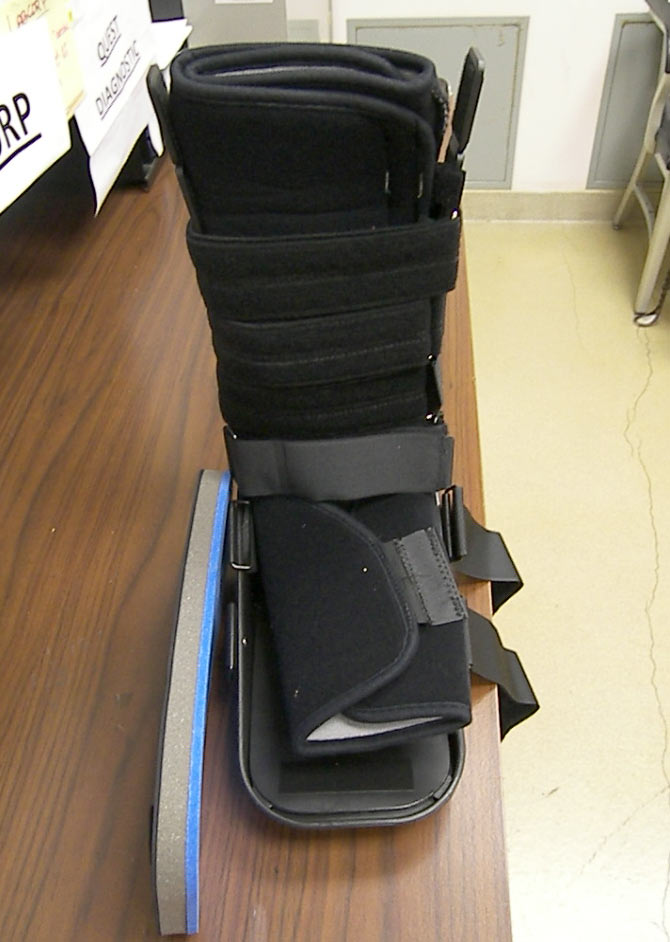By Katherine H. Jones, Michael R. Backhouse, and Julie Bruce
Offloading devices improve healing of diabetes-related foot ulcers (DFUs) but they can limit mobilization. Rehabilitation during or after removal of these devices may promote physical activity in a population at risk of poor health outcomes for which inactivity is a reversible risk factor.
Diabetes-related foot ulcers (DFUs) are associated with poor health outcomes, including increased risk of infection, lower limb amputation, and mortality. Recurrence is common, with 40% of people re-ulcerating within a year of healing. The annual healthcare cost of managing DFUs is staggering.
Few studies have examined the broader health-related consequences of prolonged immobilization associated with offloading devices. Furthermore, there is limited guidance for healthcare practitioners on how best to reintroduce physical activity and rehabilitate patients, to support and encourage mobility after removal of offloading devices. This review systematically evaluated the clinical effectiveness of rehabilitation interventions designed to promote or support physical activity in people using offloading devices for DFUs.
Methods
This systematic review examined the effectiveness of rehabilitation interventions to promote physical activity during and/or after wearing an offloading device to treat diabetes-related foot ulcers. Searches using MESH terms and free-text combinations: foot ulcer, diabetic foot, casts, surgical, orthotic devices were applied to MEDLINE, Embase, The Cochrane Library and clinical trial registers for randomized and observational studies published to September 2022. Methodological quality assessment of included studies was undertaken using the Cochrane Risk of Bias (RoB 2.0) and Risk of Bias in Non-randomized studies of Interventions (ROBINS-I) tools. After review, 8 studies were included.
Results
Of the 8 included studies (n = 441 participants), 4 were randomized controlled trials (RCTs) and 4 were prospective cohorts. Total contact casts and removable cast walkers were the most popular devices for ulcer management, used in 5 studies each. Two studies investigated healing sandals and the remaining devices, used in 1 study each, included a half-shoe, shear-reducing walker, cast shoe, prefabricated forefoot-offloading shoe with some other devices not described.
None of the 8 studies delivered any form of structured or unstructured rehabilitation nor prescribed a physical activity intervention at any time during the period that offloading devices were worn, nor after device removal to promote activity or support participants with returning to full mobilization.

Figure. Forest plot of ulcer healing after wearing an offloading device at 12 weeks. TCC, Total Contact Cast; CI, Confidence Interval; M-H, Mantel Haenszel
All studies reported 1 or more physical activity outcomes, measured objectively using waist or ankle-worn pedometers or wearable sensors attached to clothes or embedded within offloading devices. Activity outcomes were reported as steps over time (hours, days, or weeks), daily stride count (distance of both right and left step), gait speed, percentage of time spent in different postures (sitting, lying, standing, walking) or in postural transition, e.g., sit-to-stand and stand-to-sit. Activity monitors were used for different purposes, to capture periods of (in)activity, to determine adherence to wearing prescribed offloading devices or to examine ulcer healing by activity status. Two studies reported activity outcomes only; the remaining 6 studies also reported ulcer healing or healing-related outcomes, either as proportion healed, change in size or area, and/or time to healing. None measured ulcer recurrence. Adherence to the offloading device was reported by 5 studies. Outcomes are reported separately by study design.
RCTs: Physical activity (4 trials; n = 242 participants)
All trials reported that participants wearing total contact casts were less active compared to those wearing other removable devices. Physical activity after 4 to 12 weeks of ulcer treatment was lower amongst those wearing total contact casts compared to selected other offloading devices (half-shoe, forefoot offloading, healing sandals or removable cast), (SMD -0.45; 95% CI − 0.87 to − 0.04; P = 0.03; I2 = 56%; 4 trials, n = 242). Subgroup analysis of difference in physical activity after wearing a total contact cast versus a removable cast walker (2 trials; n = 88) demonstrated higher levels of physical activity in those wearing a removable cast walker after 12 weeks (SMD -0.69; 95% CI − 1.32 to − 0.05; P = 0.03; I2 = 53%, n = 88).
RCTs: Ulcer healing (4 trials, n = 242 participants)
Overall, odds of ulcer healing were higher in participants wearing non-removable total contact casts compared to all other removable devices combined after 12 weeks of treatment (OR 2.69; 95% CI 0.97 to 7.45; P = 0.06; I2 = 64%; 4 trials, n = 242) (Figure). Subgroup analysis examining differences in ulcer healing between total contact casts versus removable cast walkers also demonstrated greater odds of healing in those wearing a removable cast walker after 20 weeks (OR 3.93; 95% CI − 1.48 to 10.47; P = 0.006; I2 = 0%; 2 trials; n = 88).
Observational studies: Physical activity (4 studies; n = 196 participants)
Overall, findings from the observational studies suggested low levels of activity while people wore devices. In a cohort with 13-week follow-up, 40 participants were advised to be completely non-weight-bearing for the first 48 hours after total contact cast application, although most walked on the cast during this early period (median 808 steps over 48 hours). Total step count was low over the remaining observation period (median total 2,083 steps/day). A USA/UK cohort study (n = 79) reported higher daily activity levels in those fitted with a removable cast walker, being active for over 6 hours per day (mean 6.7 hours; SD 3.8) over 6 weeks, with adherence data suggesting the device was worn over half of time while active (59% [SD 22]). In contrast, a cohort study with 20 participants found that even when monitored for only 1 week, adherence to a removable cast walker was poor. Participants were less active while wearing their cast (mean total daily steps 345 ([SD 219] vs. 874 [SD 828] when not wearing cast; P = 0.01) with only 28% of total daily activity occurring while the cast boot was worn. Similarly, the Jordanian cohort study of 57 participants wearing removable cast walkers also reported poor adherence of 34% of activity time, when monitored for only 1 week.
Observational Studies: Ulcer healing (2 studies; n = 119 participants)
In the multicenter USA/UK cohort, only 19/79 (24%) ulcers healed over 6 weeks, although mean ulcer size reduced from 230mm2 to 106mm2 (P = 0.001). Ulcer healing was associated with better adherence to the offloading device although sample sizes were too small for meaningful analyses. Ulcer healing was higher in the cohort study with longer follow-up, with 32/40 (80%) healed after 13 weeks of total contact cast treatment.
Conclusion
Clinical experts have recently challenged traditional wisdom that activity should be limited during DFU offloading, suggesting that prescribed inactivity may be detrimental to health. Biological tissues respond to the load placed upon them, increasing or decreasing tolerance to stress depending on load. Reduced mechanical loading on the plantar surface of the foot may decrease the ability of tissues to withstand future stress, thereby making tissues more vulnerable to future injury. Recent epidemiological data appears to provide some support for this theory: sedentary time was the strongest predictor of ulcer development and had greater prognostic ability than traditionally recognized risk factors, such as ischemia and neuropathy. International guidelines now recommend that weight-bearing activity can be carefully encouraged in people with diabetic peripheral neuropathy.
Despite the entirely plausible hypothesis that rehabilitation may benefit patients with DFUs, the main finding of this systematic review was that there was no evidence to conclude whether rehabilitation is safe, or clinically or cost-effective. This is a missed opportunity to improve outcomes in people undergoing active ulcer treatment. There is clinical uncertainty and given the scale of the clinical problem, further research is urgently needed to develop and test a targeted rehabilitation package within a high quality, well-designed clinical trial.
This article has been excerpted from “Rehabilitation for People Wearing Offloading Devices for Diabetes-related Foot Ulcers: A Systematic Review and Meta-analyses,” J Foot Ankle Res 16, 16 (2023). https://doi.org/10.1186/s13047-023-00614-2. Editing has occurred, including the renumbering or removal of tables, and references have been removed for brevity. Use is per CC BY 4.0 International License.









